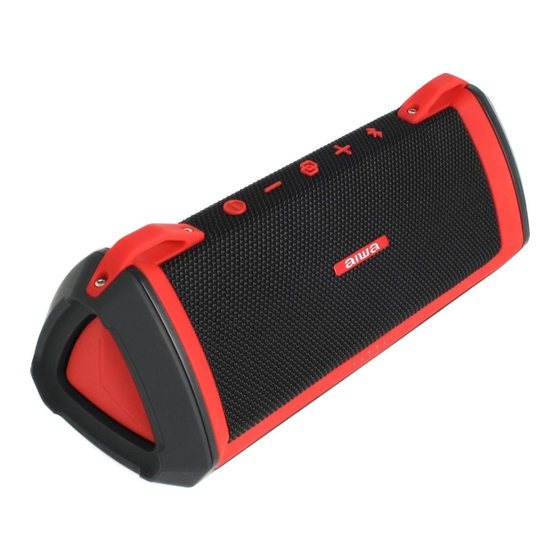
Advertisement
Quick Links
Quick Start Guide
Aiwa Exos-3 User Manual
Aiwa Corporation
service@aiwa.us.com
(888) 982-8561
Exos-3 Features
• IP67 Waterproof
• Stereo pairing of two speakers
• Onboard DSP
• Two subwoofer radiators
• USB power bank
Package Contents
1
2
3
• Speaker
• USB-C Charging Cable-50CM / 3.5 mm AUX-IN Cable 50CM
• Strap
• USB Power adapter
• User Manual
Model No: AIWA Exos-3
Input : DC 5V / 2A
Battery:Li-ion 7.4V/5000mAh
Specifications
Supported profiles: AVRCP V1.6, A2DP V1.3, HFP V1.7, HSP V1.2
Bluetooth range: 33 feet (10m)
Dimensions: 282*124*124 mm
Internal battery: Li-Ion 7.4V/5000mAh
USB-C Charging input: DC 5V 2A
USB Charging output: DC 5V 1A
Speaker diameter: φ70mm*2 + 30mm*1
Impedance: 4Ω
Max power output: 20W * 2 + 6W * 1
Frequency response: 50HZ-20KHZ
Signal to noise ratio: 80 db
THD: ≤1%
4
5
Controls, Connectors and Lights
5. Power Button
6. USB-A Port
9. Bluetooth Indicator
1. Stereo Pair button
3. - Button
2. + Button
4. Bluetooth
7. USB-C Port
8. AUX -In
11. Aux Indicator
10. Charge Indicator
Advertisement

Summary of Contents for Aiwa Exos-3
- Page 1 • Onboard DSP Internal battery: Li-Ion 7.4V/5000mAh • Two subwoofer radiators USB-C Charging input: DC 5V 2A • USB power bank Aiwa Exos-3 User Manual USB Charging output: DC 5V 1A Speaker diameter: φ70mm*2 + 30mm*1 Package Contents Impedance: 4Ω...
- Page 2 4. Connect your phone or tablet to the primary speaker via Bluetooth or Aux input to the Stereo Pair Button In your device’s Bluetooth settings, select “Aiwa Exos-3.” Once paired, an audible prompt will primary speaker. Pairs two Exos-3 speakers for stereo sound indicate the successful pairing and the blue LED light will illuminate solidly once paired.
- Page 3 FCC Statement This device complies with part 15 of the FCC Rules. Operation is subject to the condition that this device does not cause harmful interference (1) this device may not cause harmful interference, and (2) this device must accept any interference received, including interference that may cause undesired operation.













Need help?
Do you have a question about the Exos-3 and is the answer not in the manual?
Questions and answers